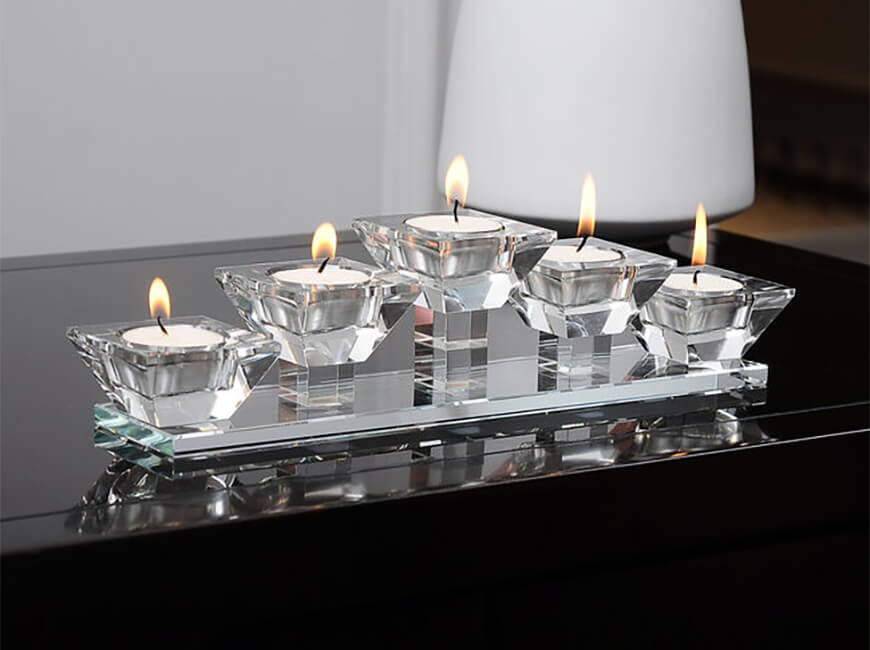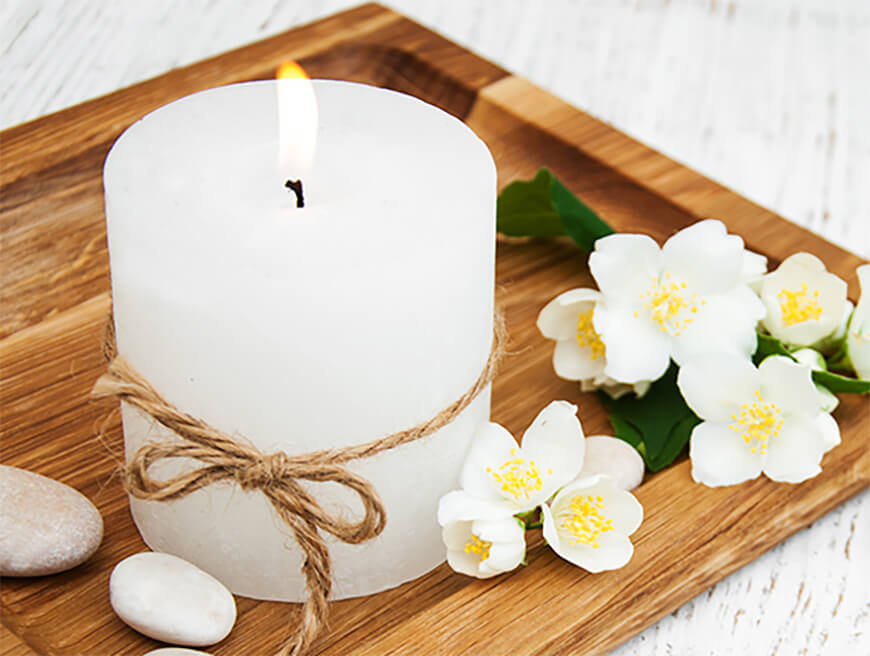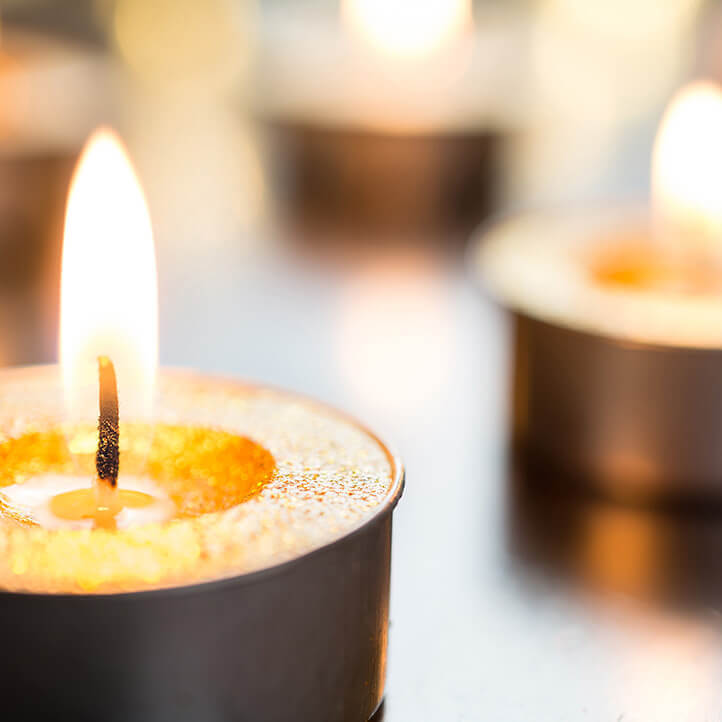Candles Care Guide
At Home Store + More, we want you to experience maximum enjoyment and pleasure from our candles. A great candle experience begins with proper candle care and maintenance. It is also very important that you burn candles safely, responsibly and according to the manufacturer’s instructions. Learn how to make your candle last longer and avoid any safety risks with this handy guide to candle care and safety.
Care & Maintenance Tips:
Prevent ‘Tunnelling'
Candle tunnelling is when a candle burns a tunnel through its centre, leaving a rim of hard wax called a ‘memory ring’ around the outside. Once a candle has this memory ring, it will continue to tunnel and burn that way. This can greatly reduce the life of your candle and cause you to lose the wick eventually. It can happen to any candle, regardless of its cost or quality.
A candle’s first burn is very important to prevent tunnelling. When you light your new candle for the first time, let it burn one hour for every 1 inch of its diameter. You should also allow the melted wax pool to reach the edge of the holder, jar or tumbler on its first burn to avoid a memory ring.
Store Candles Properly
Candle wax and fragrance can be sensitive to temperature and light. Store candles in a cool, dry place and out of direct sunlight when not in use for long periods of time. This will protect them from fading and discoloration, as well as helping to preserve the strength of the fragrance. Extreme cold also causes cracking and separation of candle wax, so do not leave candles in a place where the temperature can get very low.
Safety Tips:
Keep the Wick Trimmed
Keeping your wick trimmed is both a care and safety issue. Long or crooked wicks can cause a high flame, increasing the risk of fire. They can also cause dripping, excessive smoking and uneven burning that reduces candle life. It is recommended that you trim the wick after every 4 hours of burn time. Before doing this, you should always extinguish the flame first and let the candle come to room temperature (this can take up to 2 hours). A good rule of thumb is to trim the wick to 1/8 of inch before relighting. Use a good pair of scissors to create a nice, clean cut.
Never Leave a Candle Unattended
The most basic and important rule of candle safety is to always keep a burning candle within sight. Extinguish all candles when leaving a room or before going to sleep.
Keep Out of Reach of Children and Pets
Keep candles on a high surface where they can not be easily picked up or knocked over by little ones or furry friends.
Burn on a Heat-Resistant Surface
Always use a candleholder specifically designed for candle use. The holder should be heat resistant, sturdy and large enough to contain drips or melted wax. Be sure the candleholder is placed on a stable, heat-resistant surface. This will also help prevent possible heat damage to underlying surfaces and prevent glass containers from cracking or breaking.
Don’t Burn for More than 4 Hours
Do not burn a candle longer than the manufacturer recommends. Most candle manufacturers recommended a four-hour max burning time. At this point, the candle should be extinguished, allowed to cool for two hours, and trimmed before relighting.
Keep Away from Anything that can Catch Fire. Avoid Drafts.
More than half of all candle fires start because of candles that were left too close to flammable items. Never burn a candle on or near drapes, bedding, carpets, books, paper, decorations or anything else that can easily catch fire. Candles should be also be burned away from other sources of heat such as television sets or direct sunlight.
On that note, it is also important to keep burning candles away from drafts, vents, ceiling fans and air currents, as these can blow lightweight items such as curtains or paper into the flame. Keeping candles away from drafts can also help to prevent rapid burning, flame flare-ups and sooting.
Keep a Safe Distance Between Candles
Grouping candles can create a beautiful ambiance in a room. If you like to do this, make sure that you keep the candles 10cm apart. This ensures that they won't melt into one another, create drafts that can cause the candles to flare, or generate enough heat for one or more of the candle holders to crack.
Be Watchful for Excessive Flames and Smoke
Extinguish a candle if it flickers repeatedly, smokes, or the flame becomes too high, as the candle is not burning properly or safely. Let it cool, trim the wick and check for drafts before re-lighting. It is also important to keep the wax pool free of wick trimmings, matches and debris, as this can cause excessive flames and smoking.
Follow the ½ Inch Rule
Stop using a candle when half and inch of wax remains at the bottom of the jar. This will prevent possible heat damage to the surface on which the candle burns. Burning a candle all the way down may also cause the glass of the candle holder to become too hot and crack.
Candles Care Guide
Introduction
At Home Store + More, we want you to experience maximum enjoyment and pleasure from our candles. A great candle experience begins with proper candle care and maintenance. It is also very important that you burn candles safely, responsibly and according to the manufacturer’s instructions. Learn how to make your candle last longer and avoid any safety risks with this handy guide to candle care and safety.
Care & Maintenance Tips:
Prevent ‘Tunnelling'
Candle tunnelling is when a candle burns a tunnel through its centre, leaving a rim of hard wax called a ‘memory ring’ around the outside. Once a candle has this memory ring, it will continue to tunnel and burn that way. This can greatly reduce the life of your candle and cause you to lose the wick eventually. It can happen to any candle, regardless of its cost or quality.
A candle’s first burn is very important to prevent tunnelling. When you light your new candle for the first time, let it burn one hour for every 1 inch of its diameter. You should also allow the melted wax pool to reach the edge of the holder, jar or tumbler on its first burn to avoid a memory ring.
Store Candles Properly
Candle wax and fragrance can be sensitive to temperature and light. Store candles in a cool, dry place and out of direct sunlight when not in use for long periods of time. This will protect them from fading and discoloration, as well as helping to preserve the strength of the fragrance. Extreme cold also causes cracking and separation of candle wax, so do not leave candles in a place where the temperature can get very low.


Safety Tips:
Keep the Wick Trimmed
Keeping your wick trimmed is both a care and safety issue. Long or crooked wicks can cause a high flame, increasing the risk of fire. They can also cause dripping, excessive smoking and uneven burning that reduces candle life. It is recommended that you trim the wick after every 4 hours of burn time. Before doing this, you should always extinguish the flame first and let the candle come to room temperature (this can take up to 2 hours). A good rule of thumb is to trim the wick to 1/8 of inch before relighting. Use a good pair of scissors to create a nice, clean cut.
Never Leave a Candle Unattended
The most basic and important rule of candle safety is to always keep a burning candle within sight. Extinguish all candles when leaving a room or before going to sleep.
Keep Out of Reach of Children and Pets
Keep candles on a high surface where they can not be easily picked up or knocked over by little ones or furry friends.
Burn on a Heat-Resistant Surface
Always use a candleholder specifically designed for candle use. The holder should be heat resistant, sturdy and large enough to contain drips or melted wax. Be sure the candleholder is placed on a stable, heat-resistant surface. This will also help prevent possible heat damage to underlying surfaces and prevent glass containers from cracking or breaking.
Don’t Burn for More than 4 Hours
Do not burn a candle longer than the manufacturer recommends. Most candle manufacturers recommended a four-hour max burning time. At this point, the candle should be extinguished, allowed to cool for two hours, and trimmed before relighting.
Our Best Sellers
Keep Away from Anything that can Catch Fire. Avoid Drafts.
More than half of all candle fires start because of candles that were left too close to flammable items. Never burn a candle on or near drapes, bedding, carpets, books, paper, decorations or anything else that can easily catch fire. Candles should be also be burned away from other sources of heat such as television sets or direct sunlight.
On that note, it is also important to keep burning candles away from drafts, vents, ceiling fans and air currents, as these can blow lightweight items such as curtains or paper into the flame. Keeping candles away from drafts can also help to prevent rapid burning, flame flare-ups and sooting.
Keep a Safe Distance Between Candles
Grouping candles can create a beautiful ambiance in a room. If you like to do this, make sure that you keep the candles 10cm apart. This ensures that they won't melt into one another, create drafts that can cause the candles to flare, or generate enough heat for one or more of the candle holders to crack.
Be Watchful for Excessive Flames and Smoke
Extinguish a candle if it flickers repeatedly, smokes, or the flame becomes too high, as the candle is not burning properly or safely. Let it cool, trim the wick and check for drafts before re-lighting. It is also important to keep the wax pool free of wick trimmings, matches and debris, as this can cause excessive flames and smoking.
Follow the ½ Inch Rule
Stop using a candle when half and inch of wax remains at the bottom of the jar. This will prevent possible heat damage to the surface on which the candle burns. Burning a candle all the way down may also cause the glass of the candle holder to become too hot and crack.









